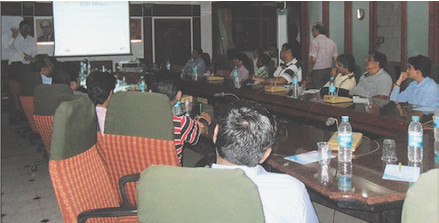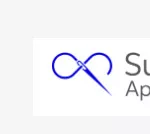The Surat Regional Office of the Synthetic & Rayon Textiles Export Promotion Council (SRTEPC) – in association with Vadilal Forex and Consultancy Service Ltd. – organized a Workshop on Foreign Exchange Risk management titled “How to survive and prosper in difficult times” in Surat on 3rd August 2013.
The objective of the Seminar was to familiarize member exporters in Surat region with the Foreign Exchange Market and identify hedging tools to manage forex fluctuations in recent times. In the current scenario of highly volatile foreign exchange transactions, such expertise in Forex Management should help exporters in reducing the risk in Foreign Exchange transactions efficiently. The Workshop was attended by about 30 representatives of member companies of SRTEPC.
Shri Sri Narain Aggarwal, Regional Chairman of SRTEPC introduced the expert Shri Hemendra Bhatia, DGM – M/s. Vadilal Forex and Consultancy Services Ltd to the audience.
Highlights Of Presentation :
Rupee Volatility & Depreciation :
Shri Bhatia explained that the widely perceived idea that Rupee has depreciated heavily since 2008 is actually a myth. He emphasized that the Nominal Rupee Depreciation is largely due to Inflation and lack of Real Appreciation. If one compares CPI – Urban Inflation of US and India e.g from June 2008 to June 2013, then there is no Real Appreciation or Depreciation. The Currency should be trading USD/[email protected]. Changing the Base, the Basket of Countries, Currencies, Inflation Indices and methodology may
give differing results. However, the moot point he underscored was that Rupee has not Depreciated in Real Terms as heavily (nearly 50%) in Five Years, as it appear to most of us.
Inflationary Pressures :
Inflation after retreating from double digit is once again rising after crude prices topping $110 per barrel. Food prices are at an all time high with heavy speculative actions taking prices higher. Inflation erodes the value of rupee and hurts most to the weakest section of the society. It is politically unpopular and also raises governments borrowing cost. GoI’s Fiscal policies may be the reason for persisting inflation. Inflation makes Domestic Goods Costlier and Foreign Goods Cheaper (unless the Currency Depreciates) thus Encouraging Imports and Reducing Exports. It also encourages Gold Import as a Hedge against Inflation – one of the biggest Item on Import Bill in India. All these widen the Trade Deficit – which currently stood @ 191bn USD (10.7% of GDP) and for Q1 April – June 2013 @ around 50bn$ (11.21% of GDP) causing not only huge Current Account Deficit but severe Balance of Payment problems first time since 1991.
Sluggish Industrial Growth :
From expectations of double digit growth we are at decade low growth with industrial production on a constant decline and GoI lowering its own growth forecast to near 5% that also with doubts for 2013-2014.
Forex Risk & Hedging Strategies :
After outlining the problems faced by the Indian Rupee and the Economy, Shri Bhatia turned his attention to the tendency of the Trade to always Hedge the exports and leave imports and liabilities open – due to Dollar Trading at Premium to Rupee. He went on to explain that always selling USD is not the best thing as what you get is Interest rate differential (Premium) and what you risk is Inflation differential. If Interest rate differential remains lower than inflation differential for too long, it becomes huge risk. He also tried to dispel the popular myth that the premiums are the indicator of Future prices. Importers can guard against currency depreciation by using any of the following tools without locking forward rates :
Buy Out of The money (OTM) call options : When an Importer has Imported Goods with Costing of Rs. 58/USD and the USD/INR Forward Rate is 61. The Importer is worried that the Rate may go to Rs. 63-64/USD. At the same time they are not willing to take a loss of Rs. 3/USD on there booking now. If they book now @ Rs. 61 and the rate goes back to Rs. 59 then they would lose. In such a Scenario the Importer may buy Call Option of say Strike Price Rs. 61.50 – @ Premium of 50 Paise. This would mean the Importer would buy Dollars @ 61.50 if the rate is above 61.50 and at market rate if the Rate is below 61.50. Say the Market rate is 63 – he would buy @ Rs. 61.50 + 50 Paise Premium already paid. So his effective cost would be Maximum Rs. 62. If on the other hand the rate is Rs. 59- they would buy Dollars @ Rs. 59 + 50 Paise Premium already paid, there effective cost would be Rs. 58.50.
Sell Put : Sell Put is usually not an ideal way to hedge-particularly in the Current Scenario of Rupee Depreciation. However, if an importer has to import and supply the material for a Project where there is Cost Escalation Clause but no de-escalation clause whereby if the landed cost goes-up they can pass on the Price rise, but not required to pass on the gains. They can sell Put against Payables – and quote more Competitive rate. Say – Currently USD/INR is Trading @ Rs. 61. The Contract says that if USD/INR goes above 61-I, they would get the benefit of cost escalation clause but if the rate goes below 61- they need not pass on the gain. Importer would sell Put Options of 61 – say at Premium of Re. 1. This means-effectively there Landed Cost would be Rs. 60 per Dollar paid as against 61. This would enable importer to go for a competitive quote. Importer is exposed to USD/INR going above 61- but that they can recover.
Buy Call/Sell Put : In this if an importer had Imported Goods – considering Cost @ 58.50 – and did not hedge. Now the Rate is 61. They would not want to miss the opportunity if the Rate goes back to 58 i.e. cost rate. Importer would like to book in any case, if the rate were to touch 58. At the same time they may not want the unlimited risk and calculate that they can afford till the rates goes to 63. In this case importer could buy Call Option with Strike Price 63 and Sell Put Option with Strike Price 58. Say Premium for Call is 50 Paise and Put is 25 Paise so they would pay upfront 25 Paise. Because of Call – if the Rate is say 66 – they would still pay @ 63. Only. At the same time if importer sold Put Option- means – they would be under obligation to buy Dollars @ 58 Even if the rate goes down to say 57. Essentially it means if the rate is below 58-importer would pay 58 + 25 paise premium paid-Effective 58.25. Between 58 and 63, importer would pay Market Price (+ 25 Paise Premium paid). Above 63 – they would pay 63.25 (63 + Premium).
Buy Call Spread : If an importer has Foreign Currency Borrowing falling due after Three Years, they would not like to take unlimited risks on this. For hedging they can Buy Call Option @ Strike Price Rs. 61. The Premium say comes to 10 Rs. Importer estimates that there is a huge risk of it going up to Rs. 76/USD. However, beyond Rs. 76/USD the probability is less, so importer will want to hedge risk up to 76. So they will buy a Call strike 61 and Sell Call Strike 76 – Premium 4 Rs. Net Premium Paid 6 Rs. Meaning – if after three years – the rate is below 61 – say 59 importer would get Dollars @ Market Rate – 59 (+6 Premium). If the Rate is between 61 and 76 say 72 – importer would buy Dollars @ 61 (+6 Premium). If the Rate is above 76- say 80, they would get the Rate @ Market Price 80 – 15 Rs = 65 (+6 Premium). Thus importer is protecting against Rupee depreciation of 15 Rs by paying 6 Rs and without giving up on any Rupee appreciation.
Seagull : In this if an importer has to protect against 15 Rs depreciation but finds the Price of 6 Rs too high. They will not mind giving up on any gains beyond say 58 – as they are saving huge interests costs on ECB in any case. Importer would go for what is called Buying Seagull i.e. they would buy Call @ 61 – Premium 10, Sell Call @ 76 Premium – 4. Additionally sell Put @ 58 – Premium 1. This means the same as in above example whereby if the Rate is below 58 – importer would still have to buy Dollars @ 58. They would in return pay the lower net premium @ Rs 5. Now – if the Rate is Below 58- say – 55 importer would buy Dollars @ 58 (+5 Premium) – instead of 55 (+ 6 Premium). If the rate is Between 58 and 61 – say 59 – they would buy Dollars @ 59 (+ 5 Premium) instead of 59 (+6 Premium) – same as above (except Lower Premium). If the Rate is between 61 and 76 – say 72 – importer would buy @ 72 (+5 Premium) instead of 72 (+6 Premium). If the Rate is above 76 – say 8 – he would buy @ Market-15 = 80-15- >65 (+ 5 Premium) instead of 65 (+6 Premium). So essentially- if the rate is below 58- the Seagull buyer would be worse off than Call Spread Buyer and quantum is unlimited – otherwise they are better off – the quantum is fixed @ One Re.
Buyer’s Credit : On suitability or otherwise of Buyer’s Credit for Importers, Shri Bhatia advised that Buyers credit should be cautiously used. It should not be used to play on Exchange rate. If done so it should be with strict stop loss and target and same should be adhered to. He explained with illustration how Re. Depreciation can cause effective cost of Buyers Credit to be in excess of 30%.
Conclusion : Shri Bhatia viewed that importers have serious business risks if USD/INR slips to 67 or even stays at 61 for long. In such scenario it was stressed that it is of utmost important to have a proper risk management policy in place. Exporters have to take a risk view on there balance sheet rather than targeting any rates. What is the risk we can afford to take? Should they go for options and pay premium like a insurance policy? What are the structures and rates between which they can operate with minimum risk? Should they use one tool or mix of tools? It is not always advisable to leave everything on views and responsibility for Risk management should be fixed.
At the end, Shri Bhatia stated that there was a need to have a very clear understanding of factors having high, low & medium risk. There has to be a policy to deal with all these levels of risk within a established structure defined clearly stating do’s and don’t’s. The event was followed by an interactive Q&A session.
Mr. Aggarwal presented the vote of thanks.





